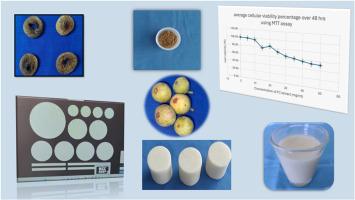结合无花果种子提取物的3d打印临时牙科树脂的颜色表征、机械性能和抗菌活性的体外评估
Q1 Medicine
Journal of oral biology and craniofacial research
Pub Date : 2025-08-28
DOI:10.1016/j.jobcr.2025.08.028
引用次数: 0
摘要
研究背景无花果以其具有生物活性的植物化学物质和抗菌潜力而闻名;然而,评估其在3d打印临时牙科树脂的颜色,机械性能和抗菌活性方面的结果的研究是缺乏的。因此,本研究评价了无花果籽提取物掺入对3d打印临时冠桥树脂的颜色评价、抗折强度、抗压强度、显微硬度和抗菌活性的影响。材料和方法共制备240份样品,其中60份样品按Ficus carica种子提取物掺入3D临时树脂的0%、1.5%、2.5%和5%分为4组。在基线使用分光光度计评估颜色分析。机械性能包括抗弯强度、抗压强度和维氏显微硬度根据标准化方案进行评估。通过测定抑制区和计算菌落形成单位(CFU/mL)来检测对白色念珠菌、金黄色葡萄球菌和牙龈P的抑菌活性。数据分析采用单因素方差分析,随后进行Tukey’s HSD事后检验。p值为<;0.05被认为具有统计学意义。结果颜色性能得到改善,ΔE由对照组的0.5042±0.186降至5%组的0.0700±0.026,均在临床可接受范围内。与对照组相比,D组(5%)的力学性能显著增强(p < 0.001)。平均抗压强度从65.92±1.02 MPa(对照组)增加到76.09±0.57 MPa(5%组)。抗折强度由55.77±0.49 MPa提高到69.53±0.60 MPa,显微硬度由11.17±0.50 VHN提高到14.02±0.31 VHN。抗菌活性显示出剂量依赖性的增加,5%组在所有测试生物中显示出最高的抑制区和最大的微生物计数减少。结论加入5%的无花果籽提取物可提高3d打印临时冠桥树脂的机械强度、颜色和抗菌效果。本文章由计算机程序翻译,如有差异,请以英文原文为准。

In vitro evaluation of color characterization, mechanical properties, and antimicrobial activity of 3D-printed provisional dental resin incorporated with Ficus carica (Fig) seed extract
Background of the study
Ficus carica known for its bioactive phytochemicals and antimicrobial potential; however, studies evaluating its outcome on the color, mechanical properties and antimicrobial activity of 3D-printed provisional dental resins are lacking. So this study evaluate the effect of Ficus carica seed extract incorporation on the color assessment, flexural strength, compressive strength, microhardness and antimicrobial activity of 3D-printed provisional crown and bridge resin.
Materials and methods
A total of 240 samples were prepared, with 60 samples allocated to four groups based on 0 %, 1.5 %, 2.5 %, and 5 % of Ficus carica seed extract incorporated into 3D provisional resin. Color analysis was evaluated using a spectrophotometer at baseline. Mechanical properties including flexural strength, compressive strength, and Vickers microhardness were assessed according to standardized protocols. Antimicrobial activity was tested against C albicans, S aureus, and P gingivalis by measuring zones of inhibition and calculating colony-forming units (CFU/mL). Data were analyzed using one-way ANOVA, followed by Tukey's HSD post hoc test. A p-value of <0.05 was considered statistically significant.
Results
Color property improved, with ΔE decreasing from 0.5042 ± 0.186 (control) to 0.0700 ± 0.026 in the 5 % group, remaining within clinically acceptable limits. The Group D (5 %) showed significantly enhanced mechanical properties compared to the control (p < 0.001). Mean compressive strength increased from 65.92 ± 1.02 MPa (control) to 76.09 ± 0.57 MPa in the 5 % group. Flexural strength improved from 55.77 ± 0.49 MPa to 69.53 ± 0.60 MPa, and microhardness increased from 11.17 ± 0.50 VHN to 14.02 ± 0.31 VHN. Antimicrobial activity demonstrated a dose-dependent increase, with the 5 % group showing the highest inhibition zones and greatest reduction in microbial counts across all tested organisms.
Conclusion
Ficus carica seed extract incorporation especially at 5 % enhances the mechanical strength, color, and antimicrobial efficacy of 3D-printed provisional crown and bridge resin.
求助全文
通过发布文献求助,成功后即可免费获取论文全文。
去求助
来源期刊

Journal of oral biology and craniofacial research
Medicine-Otorhinolaryngology
CiteScore
4.90
自引率
0.00%
发文量
133
审稿时长
167 days
期刊介绍:
Journal of Oral Biology and Craniofacial Research (JOBCR)is the official journal of the Craniofacial Research Foundation (CRF). The journal aims to provide a common platform for both clinical and translational research and to promote interdisciplinary sciences in craniofacial region. JOBCR publishes content that includes diseases, injuries and defects in the head, neck, face, jaws and the hard and soft tissues of the mouth and jaws and face region; diagnosis and medical management of diseases specific to the orofacial tissues and of oral manifestations of systemic diseases; studies on identifying populations at risk of oral disease or in need of specific care, and comparing regional, environmental, social, and access similarities and differences in dental care between populations; diseases of the mouth and related structures like salivary glands, temporomandibular joints, facial muscles and perioral skin; biomedical engineering, tissue engineering and stem cells. The journal publishes reviews, commentaries, peer-reviewed original research articles, short communication, and case reports.
 求助内容:
求助内容: 应助结果提醒方式:
应助结果提醒方式:


